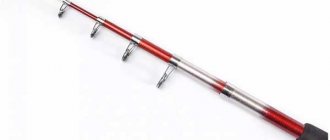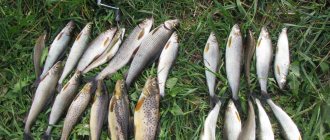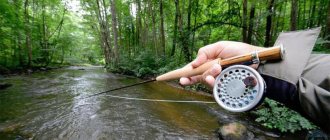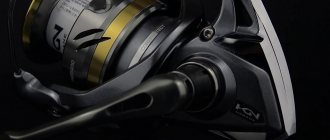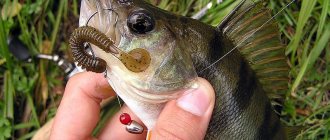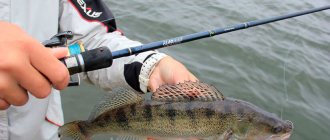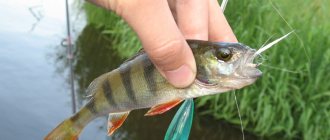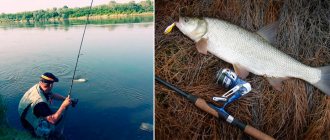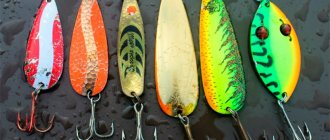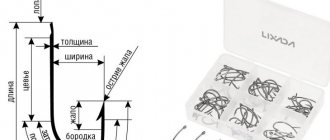Test - what is it
Manufacturers of spinning rods indicate the test directly on the form of the rod. Two letters S.W. or the word “test” denotes a test of a spinning rod based on the weight of the bait; in short, it is simply called: “spinning rod test.” The word “line” refers to a spinning rod test along a fishing line.
The test consists of two numbers indicating the minimum and maximum weight of the bait used for this rod. Using bait with a larger or smaller weight that goes beyond the boundaries of the test is of course possible, but it is extremely undesirable and ineffective. If the bait is too heavy for the rod, it can break it when casting, and if it is too light, it will be difficult to cast it to the desired distance.
How to choose a spinning rod test based on bait weight
The test is marked, for example: “CW 5 – 20g”. Where CW (casting weight from English weight test) is measured in grams, sometimes in ounces (oz). If the test value is 5–20 grams, then it is advisable to use baits weighing 5 grams or more, but not heavier than 20 grams. The optimal weight is the arithmetic mean of two values ((5+20)/2=12.5). Thus, bait weighing 12.5 grams is best suited for spinning with such a test. This weight will ensure the longest cast and will feel better when retrieving.
The real test has a narrower gradation of values. It is calculated by subtracting the minimum value (12.5-5=7.5 g) from the average weight (this will be the minimum real value) and adding the minimum value (12.5+5=17.5 g) to the average. The obtained result of the real test is 7.5–17.5 g. A bait of this weight is best suited for spinning with a cast of 5–20 g and will contribute to long casting and a good catch.
Such a simple calculation will help a novice fisherman, when purchasing gear, easily decide on the spinning rod model and the choice of bait.
Spinning line test
After choosing the bait, you need to choose the appropriate fishing line for the spinning rod. If the weight is too heavy, the spinning rod will break. A fishing line that breaks before the tackle breaks can save it. Such a fishing line should not be very strong, but also not very thin, otherwise it will break from the weight of the bait itself during casting. It is necessary to choose the fishing line that the spinning rod can withstand at its maximum breaking load.
Spinning rods and fishing lines are pre-tested for strength and breaking capacity, respectively. The result of such experiments is entered into the rod characteristics form in the form of a line test, or, as the international meaning is accepted, “Line test”. The line test is indicated on the rod blank and is measured in pounds (lb) or kilograms (kg). One pound equals approximately 0.46 kg. It’s easy to find the test, just find the word “line” on the form and two numbers indicating the minimum and maximum load weight that the fishing line can withstand without breaking the rod.
For example, in the characteristics of a spinning rod there is a marking “line 8 – 17lb”. This means that fishing line from 8 to 17 pounds is suitable for this tackle. For convenience, we convert into kilograms: (8*0.46=3.7kg) and (17*0.46=7.8). This means that the line test is 3.7–7.8 kg.
The minimum value indicates that a line with a tensile strength of less than 3.7 kg is not recommended for use with this rod. If it is less, the line may break when casting. The upper value shows that using a fishing line with a tensile strength higher than 7.8 kg is not recommended because if the load is higher than this value, the fishing line will withstand, and the spinning rod may break. It is best to choose a line with an average tensile strength because the test is not always specified correctly.
Practical advice
Infrequently, but there are still cases when fishermen are faced with a problem: how to determine the test of a spinning rod if there is no marking on it . This question may arise, for example, when while fishing you have to use someone else’s form, without markings. Or after repairing the rod, associated with gluing or replacing one of its legs or tip. In this case, as is known, the characteristics of the form change somewhat.
There is a proven way to determine the spinning test at home or on a pond. It is based on the shock-absorbing properties of modern fishing rods and consists of the following stages:
- Equip the form with a reel with thin fishing line that is convenient for you.
- Prepare several weights of different weights, which, in your opinion, approximately correspond to the test characteristics of this form.
- Next, you need to cast these loads, starting with one of the lightest. The casting technique should be identical for all attempts.
- It has been verified that at first, with an increase in the weight of the thrown load, the casting distance also increases. As soon as it is noticed that the casting range with the next load has stopped increasing, or even decreased, the experiment should be stopped and the weight of the penultimate load should be designated as the upper test value of this rod.
- The lower test limit is determined in the reverse order - it is necessary to reduce the weight of the load with each subsequent cast. As soon as the casting distance and the bite of the rod drop to their maximum, remember this weight as the lower value of this indicator.
When performing this test, it is important that you have a good feel for the rod and that each cast is made comfortably, without tension.
Compliance of the test for the weight of bait and fishing line with the class of a spinning rod
There are three main classes of spinning test according to the weight of the bait: light (light) 5 - 15 g, medium (medium) 10 - 30 g and heavy (heavy) 20 - 50 g. In addition to these main ones, intermediate test classes are often used.
Below are the values of the classes that correspond to a certain weight of the bait; the maximum diameter of the fishing line for a given class and the maximum value of the tensile strength of the fishing line in the appropriate sequence:
Ultra-light (UL – Ultra Light), up to 7 g – Ø 18 mm – maximum 2.5 kg.
Light (L – Light), from 8 to 10.5 g – Ø 0.2 mm – maximum 4.25 kg.
Medium light (ML – Moderate Light, Medium Light), from 4 to 17 g – Ø 0.22 mm – maximum 5 kg.
Medium (M – Moderate, Medium), from 18 to 21 g – Ø 0.25 mm – maximum 6 kg.
Medium heavy (MH – Moderate Heavy, Medium Heavy), from 21 to 28 g – Ø 0.3 mm – maximum 8 kg.
Heavy (H-Hard), up to 42g – Ø 0.4 mm – maximum 12 kg.
Extra heavy (XH – Extra Heavy), more than 42 g – Ø 0.5 mm – maximum 20 kg.
These divisions into classes are quite arbitrary. They may differ from one manufacturer to another.
A spinning rod, according to its class, will have the following characteristics and equipment:
UL, L – used for catching small fish. A fairly short rod with a length of 1.5 to 2.1 m. Lightweight guides, thin fishing line with a diameter of 0.12 to 0.2 mm. Use small baits (small spoons, spinners, light plastic baits with jig heads, wobblers).
ML, M, MH are the most common gear because they are universal, they are used for catching fish of various sizes and in any conditions. The length of the spinning rod is from 2.4 to 3.3 m. Average bait weight. Line with a diameter of 0.2 to 0.35 mm.
H – used for catching large fish. The length of the rod exceeds 2.7 m. It has maximum strength. The bait is selected weighing more than 40 grams.
XH – used for trolling. The rod is very powerful and thick, has roller guides. This spinning rod has a multiplier reel that resembles a winch.
Classification of whips by test
The classification recognized among anglers, based on the form test, is quite arbitrary and may differ slightly from one manufacturer to another.
This is a consequence of the fact that each manufacturer can set this rod parameter independently, depending on its preferences and internal standards. There are no uniform standards for this characteristic. But, nevertheless, most well-known manufacturers of forms prefer the following classification according to this characteristic:
- “UL” – ultra light class. These ultralight spinning rods are designed for casting baits weighing only up to 7 grams. Due to this, they are in limited demand.
- “L” – light class. This class usually includes rods that are designed to work with baits weighing up to 12 grams.
- “ML” – medium-light class. Such forms can have a value of the parameter in question from 5 to 18 grams. Designed for catching small and medium-sized fish. For example, a spinning rod test for perch may have such numbers.
- "M" - middle class. Whips belonging to this class are designed for casting baits weighing from 10 to 25 grams. They are intended for catching medium and large specimens of predators. For example, if you have a question about which spinning rod test to choose for catching medium-sized pike, then its value should be within this particular class. Or, if you are looking for a spinning rod for asp, then the choice of test for such a spinning rod should also be carried out among the offers from this category.
- “MH” – medium-heavy class. This category includes forms with dough from 15 to 35 grams. They are used for catching medium and large fish. When determining what kind of spinning rod test is needed for catching large pike, it will be rational to make a choice among specimens of this class. This test can also be used with a spinning rod for pike perch.
- “H” (HARD) – heavy class. The forms belonging to this category are designed for casting baits weighing up to 50 grams. Spinning rods with such a large test can be used for trolling.
- “XH” (EXTRA HEAVY) – super heavy class. This class includes all rods that are designed to control baits weighing over 50 grams. Some examples of such sticks may have an upper test value of 250 g or more. What does such a test on a spinning rod mean? This means that it is designed for casting the heaviest baits and can also be used for sea fishing.
At the moment, this is perhaps the most complete classification of fishing rods according to the value of this parameter. It gives every angler a better understanding of what a spinning rod test is.
General recommendations
When purchasing a spinning rod, you need to inspect it thoroughly. It should be smooth and without cracks; the reel seat and all rings must be on the same axis; The assembled spinning rod needs to be shaken well to check the joints and fastenings and once again make sure of the integrity of the rod, inspect all elements for cracks and other defects.
In addition to a visual inspection of the spinning rod, you need to pay attention to the form with the characteristics of the rod and fulfill all the requirements when choosing equipment. Spinning rods with a wide test range are more suitable for beginners. The upper and lower values do not always correspond to reality. For this reason, it is better to select a bait based on a “real test” with a narrower range of values on both sides.
When choosing a fishing line, it is unacceptable to use it at a maximum gap value higher than that allowed by the test. The best option would be to choose closer to the average test value. The breaking load of the fishing line is indicated on the reel.
Several recommendations for choosing a test when fishing:
- If fishing on a large river, more than 100 meters wide, is carried out from the shore for large and medium-sized fish (pike perch, perch, pike), then select a rod with a length of 2.7 to 3 meters. The bait used is a spoon, jig head, wobblers. Recommended test 15–45; 10–30; 7–28 gr.
- If fishing on a fairly small river, up to 30 meters wide, is carried out from the shore for medium and small fish (perch, pike, ide, grayling), then it is advisable to choose a rod with a length of 2.1 to 2.4 meters. The same wobblers, light spoons and jig heads are used as bait. Test value 1–5; 4–16 grams.
- When fishing on a large and deep river, from a boat, for pike perch and large pike, use a spinning rod with a length of 2.1 to 2.4 meters. They use large baits such as jig heads weighing from 18 to 36 grams and large wobblers 10-15 cm long. The test value is 10–30 or 20–50 grams.
- When fishing on a pond without a current or lake, use a rod with a length of 1.8 to 2.28 meters Test value 5–20; 4–16; 3–12 grams.
- When fishing on the lake from a boat or shore using minnow-class twitching wobblers, the rod is selected from 1.8 to 2.1 meters. Baits are selected in accordance with the test. If the test is 1–7 or 3–14 grams, then use wobblers with a length of 3 to 7 cm; if the test value is 5–21 grams, it is better to use wobblers up to 10 cm long; if the test values are 7–28 grams, then large wobblers with a length of 10 to 13 cm are used.
These, of course, are just recommendations and it all depends on the conditions at the fishing site, but they will help you figure out which direction you need to move in a certain situation.
Recommendations for choosing a test form
Experienced fishermen always select a spinning rod according to the test in accordance with the baits that they have at their disposal, which they are already accustomed to using. Also, the size and weight of the prey that you can catch will largely depend on which spinning test you decide to choose.
Expert opinion
Knipovich Nikolai Mikhailovich
Zoologist, hydrobiologist. I am interested in fishing at a professional level.
Important! When choosing a fishing rod, it is very important to take into account its other parameters: length and action. Only with the correct combination of all the important characteristics can you fully experience what a spinning test is and how important it is.
For example, a spinning test for small pike , as already indicated, should start from 10 grams . The weight and size of the possible bait and, consequently, the effectiveness of this fishing gear depend on which test you choose for a spinning rod that is supposed to be used for catching large pike. For such fishing, it is recommended to take forms with this parameter from 25 g and above.
It is clear that the test values of a fishing rod for catching, for example, salmon or catfish, should belong to the heavy or even super-heavy class.
Blitz tips
- It is better to select a spinning rod from a well-known brand and buy it at trusted retail outlets.
- When choosing bait, you must strictly ensure that its weight does not exceed the limits allowed by the bait weight test.
- When choosing a fishing line, you must ensure that its maximum strength does not exceed the range of test values for the fishing line.
- It is important to strictly follow all the rules for using the fishing rod.
- It is necessary to carefully monitor and keep your gear intact and safe.
